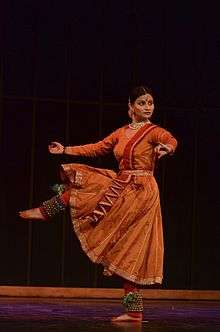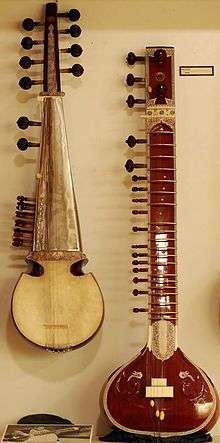Ghungroo
A ghungroo (Hindi: घुँघरू, Urdu: گھنگرو), also known as ghunghroo or ghunghru or ghungur or ghungura (Assamese & Bengali & Odia) or Chilanka or Silangai (in Malayalam & Tamil respectively), is one of many small metallic bells strung together to form ghungroos, a musical anklet tied to the feet of classical Indian dancers.[1] The sounds produced by ghungroos vary greatly in pitch depending on their metallic composition and size. Ghungroos serve to accentuate the rhythmic aspects of the dance and allow complex footwork to be heard by the audience. They are worn immediately above the ankle, resting on the lateral malleolus and medial malleolus. A string of ghungroos can range from 50 to greater than 200 bells knotted together. A novice child dancer may start with 50 and slowly add more as he or she grows older and advances in his or her technical ability. Ghungroos are worn in traditional performances of the classical Indian dance forms: Bharatnatyam, Kathak, Kuchipudi, Mohiniyattam, Lavani, Odissi etc.


Ghunghroo vadan
Ghunghroo vadan is a music AESTHETICALLY style evolved by V. Anuradha Singh, a renowned Indian classical kathak exponent. She developed bells as a main musical instrument and performs in many pure music festivals where dance is not allowed. Ghunghroo vadan focuses solely on foot movement as percussive art (100 minutes, non-stop in one place).
See also
Konguro'o
References
| Wikimedia Commons has media related to Ghungroo. |
- W. Hesse, Jr., Rayner (2007). Jewelrymaking Through History: An Encyclopedia. Greenwood Publishing Group. p. 8. ISBN 0-313-33507-9.
